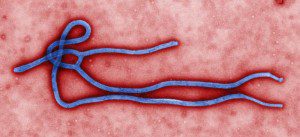

The Ebola virus that was found in 4 of 6,000 pigs in the Phillipines last year is the Reston strain. This isolate was first identified in Reston, VA, in 1989, in monkeys in a primate facility that had been shipped from the Phillipines. It infected at least 20 lab workers, but did not cause severe disease. In contrast, African strains of Ebola, such as Zaire and Sudan, are associated with high fatality rates.
It is not known how Ebola-Reston infected the Phillipine pigs. There is evidence that the reservoir for African Ebola strains is the fruit bat (or flying fox). It is possible that the virus is transmitted to primates in Africa through contaminated fruit (upon which the bats urinate or defecate while feeding) or bat meat. A recent article in Microbe Magazine explores bats as reservoirs of viruses.
Yes, there are similar fruit bats in the Phillipines. And they have been implicated previously in the transmission of other virus diseases. For example, Nipah virus, a member of the Paramyxoviridae, was first identified as the agent of respiratory illness and encephalitis in Malaysian pig farmers in 1999. This outbreak lead to 105 human deaths; one million pigs were slaughtered to stop the spread of infection. It is believed that fruit bats infected the pigs by contaminating them with urine, feces, or fruit. The pigs, in turn, infected their handlers, who are in close contact with them each day.
Given the Nipah virus scenario, it is not difficult to imagine the spread of Ebola-Reston from fruit bats, to pigs, and then to pig farmers. The pig farms are here to stay, and they only grow larger – increasing the contact between pigs and mobile wild animals. The conclusion is inescapable – more frequent contact between pigs and wild animals, more future infection of pigs with Ebola.
Dr. Pierre Rollin of the Centers for Disease Control and Prevention has said that “This virus is very stable, not like flu or HIV”. He indicated that there is no change of the virus when it travels from primates to humans. Limited genetic change is typical of a dead-end zoonotic infection: one example is the identical genome sequence of the NYC 1999 West Nile virus isolate with that of a virus from a goose in Israel. Since then, West Nile virus has undergone enormous variation as it has spread across the United States. This is typical of RNA viruses, whose genomes undergo extensive mutation. I seriously doubt that Ebola is genetically ‘very stable’ as implied by Dr. Rollin’s statement above. Rather, we have not yet seen extensive circulation in humans which would lead to a more diverse sequence pool.
I also find curious the statement by Dr. Thomas G. Ksiazek, from the University of Texas Medical School in Galveston, that It’s probably a rare event that pigs get infected. Perhaps so far it has been rare. But the rapid growth of farming is leading to more overlap between bat habitats and pig farms. It seems likely that farm animals will be taking more frequent dips in the zoonotic pool, with dire consequences.

Comments are closed.